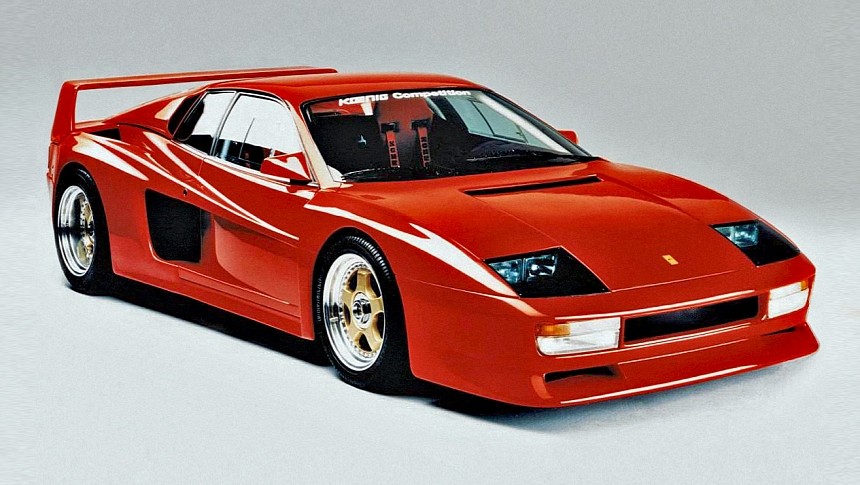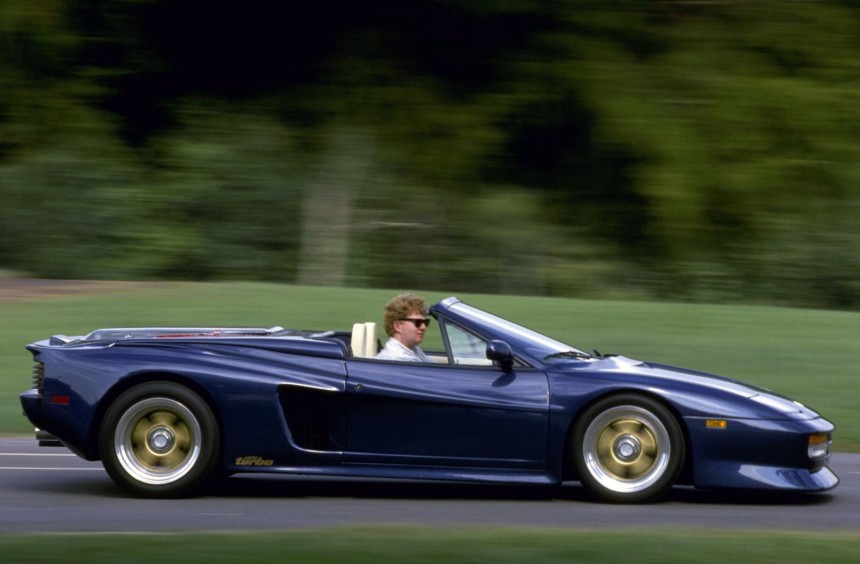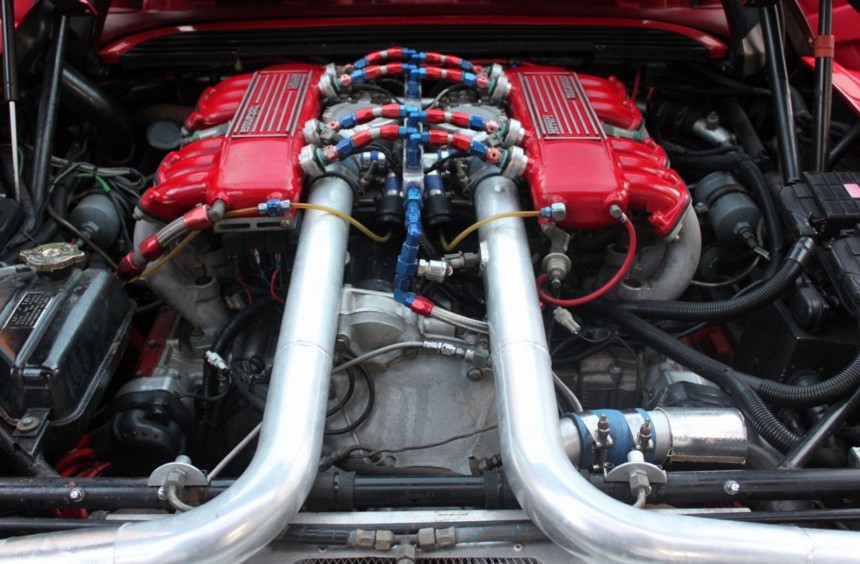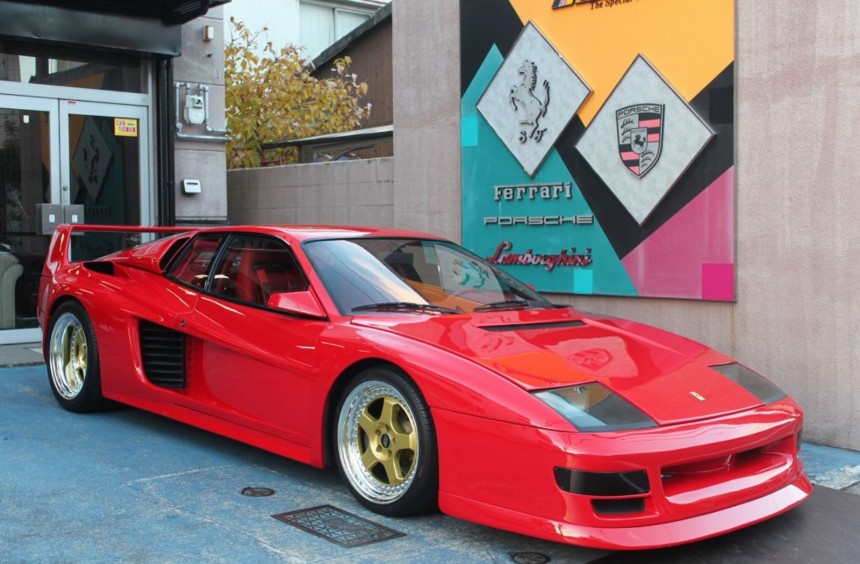These days, there’s no shortage of street-legal, high-performance sports cars with four-digit output figures, but nearly four decades ago, only a few thoroughbred race cars could make that much power.
There was, however, one notable exception; a twin-turbocharged Testarossa developed by the era’s maddest tuning house.
Founded by former amateur race driver and untreatable speed addict Willy Koenig, Munich-based Koenig Specials had made a name for itself by offering a vast list of visual and performance upgrades for the Ferrari Berlinetta Boxers. Although the Italian carmaker was less than thrilled with Koenig’s projects, wealthy BB owners from all over Europe were traveling to Germany to upgrade their beloved sports cars.
By the early-1980s, the company moved from a small garage to a bigger facility and hired Franz Albert as the head of its engineering department. The talented engineer devised a forced induction system for the BB series using aircraft turbochargers. Thus, the Koenig-tuned prancing horses became some of the fastest, most powerful sports cars that roamed the Old Continent’s public roads.
In 1984, Ferrari replaced the aging BB series with a brand-new model. Like its successor, the Testarossa featured a mid-mounted flat-twelve, but the new body designed by Pininfarina made it considerably more appealing.
In standard form, the engine could deliver 385 hp (390 ps), which made the Testarossa sensibly more powerful than the last iteration of the BB range (BB 512i). Still, that was not enough for Willy Koenig and like-minded Ferrari owners.
Therefore, in just a few months, Koenig Specials rolled out several upgrades for Ferrari’s latest model. Initially, the engine could be improved with an ECU remap, a one-piece, competition-spec air filter, and a bespoke exhaust system, components that improved output by around 50 hp (51 ps). Besides that, Koening offered several chassis tuning options, including alloy hub spacers meant to widen the car’s track, aftermarket suspension kits that could drop the ride height, and new front brakes with four-pot calipers and oversized, 355-mm grooved and drilled rotors that improved stopping power.
If that wasn’t enough and you were a Testarossa owner who wanted a car that also stood out visually, Koenig had you covered with custom spoilers, side skirts, bumpers, fixed headlights, a plexiglass engine cover that drew attention to the beautiful 4.9-liter flat-twelve, and even a host of interior enhancements like a new dash and seats, all upholstered in fine leather.
Arguably the coolest visual upgrade that money could buy was a so-called Spider conversion kit. Ferrari officially made a single convertible Testarossa for Fiat boss Gianni Agnelli, so buyers who wanted the drop-top experience went to Munich, where their cars received a redesigned rear deck, a foldable canvas top, and several reinforcements that kept the overall rigidity of the chassis intact.
As years went by, the tuning house upped the ante in terms of performance. Replicating the successful twin-turbo recipe that was used for the BB series, Koenig’s engineering department developed two distinct upgrade packages for the Testarossa.
The first beefed up the engine with a couple of intercooled KKK turbos, a re-mapped ECU, forged pistons, heavy-duty head gaskets, custom manifolds, and a bespoke exhaust. All these high-performance goodies meant that the twelve-cylinder could deliver 700 hp (710 ps), or nearly twice as much as it could make in stock form.
Naturally, this translated to impressive performance figures. The 0 to 60 mph (97 kph) sprint was achieved in 3.9 seconds, and a top speed of 200 mph (322 kph) could be reached nearly effortlessly.
If the first upgrade package was not insane enough, customers could go for the second, dubbed Evolution. It included most of the hardware available with the “standard” twin-turbo. However, it added a completely custom-built ECU, larger turbos, different intercoolers, and a modified oil pump with an oversized cooler. In this configuration, the engine was rated at an outrageous 1,000 hp and it sounded amazing even when idling, as you can see in the video below by EIGHTIES RIDER.
Because 1980s tech couldn’t prevent turbo lag, the acceleration didn’t improve by much, but in terms of top speed, a Koenig claimed that a Twin-Turbo Evolution-powered Testarossa could comfortably exceed 215 mph (356 kph). Of course, aerodynamic limitations meant that few were brave enough to push the car close to that figure, let alone attempt to find out how much faster it could go.
Apart from the aforementioned engine upgrade packages, the tuner continued to offer many body kits for the original Testarossa and the improved versions (512 TR and F512 M) well into the 1990s. By this time, owners could have cars that could spit out four-digit output figures and also look fundamentally different than the stock versions. The most dramatic visual makeover eliminated the iconic slots from the side vents and added fixed headlights, new bumpers, and a huge rear spoiler that made the Testarossa look much like an F40.
Today, these highly-modified prancing horses are controversial, to say the least. That’s mostly because of their outlandish body kits, which make Ferrari purists cringe. However, the insane 1,000-hp, twin-turbo engine found in some of these cars is hard not to appreciate.
Controversial looks aside, the market value for these legendary tuner cars is currently at an all-time high. A low-mileage Evolution example in good shape is valued around the $500,000 mark, making it far more expensive than a stock, Concours-level Testarossa. The one featured in the gallery is currently available on the Supercars for Sale platform and could be yours for $540,000. It features the 1,000-hp Evolution package, a full “F40-esque” body kit, a custom interior, and a set of bespoke OZ wheels designed exclusively for Koenig.
Whether you hate it or love it, the Koenig Specials Testarossa was an epic tuner car. With an Evolution Twin-Turbo, it delivered more power than any street-legal sports car from the eighties or nineties, and its over-the-top body kits perfectly epitomized the tuning culture of those two exciting decades.
Founded by former amateur race driver and untreatable speed addict Willy Koenig, Munich-based Koenig Specials had made a name for itself by offering a vast list of visual and performance upgrades for the Ferrari Berlinetta Boxers. Although the Italian carmaker was less than thrilled with Koenig’s projects, wealthy BB owners from all over Europe were traveling to Germany to upgrade their beloved sports cars.
By the early-1980s, the company moved from a small garage to a bigger facility and hired Franz Albert as the head of its engineering department. The talented engineer devised a forced induction system for the BB series using aircraft turbochargers. Thus, the Koenig-tuned prancing horses became some of the fastest, most powerful sports cars that roamed the Old Continent’s public roads.
Turning its attention to the Testarossa
In standard form, the engine could deliver 385 hp (390 ps), which made the Testarossa sensibly more powerful than the last iteration of the BB range (BB 512i). Still, that was not enough for Willy Koenig and like-minded Ferrari owners.
Therefore, in just a few months, Koenig Specials rolled out several upgrades for Ferrari’s latest model. Initially, the engine could be improved with an ECU remap, a one-piece, competition-spec air filter, and a bespoke exhaust system, components that improved output by around 50 hp (51 ps). Besides that, Koening offered several chassis tuning options, including alloy hub spacers meant to widen the car’s track, aftermarket suspension kits that could drop the ride height, and new front brakes with four-pot calipers and oversized, 355-mm grooved and drilled rotors that improved stopping power.
If that wasn’t enough and you were a Testarossa owner who wanted a car that also stood out visually, Koenig had you covered with custom spoilers, side skirts, bumpers, fixed headlights, a plexiglass engine cover that drew attention to the beautiful 4.9-liter flat-twelve, and even a host of interior enhancements like a new dash and seats, all upholstered in fine leather.
Arguably the coolest visual upgrade that money could buy was a so-called Spider conversion kit. Ferrari officially made a single convertible Testarossa for Fiat boss Gianni Agnelli, so buyers who wanted the drop-top experience went to Munich, where their cars received a redesigned rear deck, a foldable canvas top, and several reinforcements that kept the overall rigidity of the chassis intact.
Twin-turbo insanity
The first beefed up the engine with a couple of intercooled KKK turbos, a re-mapped ECU, forged pistons, heavy-duty head gaskets, custom manifolds, and a bespoke exhaust. All these high-performance goodies meant that the twelve-cylinder could deliver 700 hp (710 ps), or nearly twice as much as it could make in stock form.
Naturally, this translated to impressive performance figures. The 0 to 60 mph (97 kph) sprint was achieved in 3.9 seconds, and a top speed of 200 mph (322 kph) could be reached nearly effortlessly.
If the first upgrade package was not insane enough, customers could go for the second, dubbed Evolution. It included most of the hardware available with the “standard” twin-turbo. However, it added a completely custom-built ECU, larger turbos, different intercoolers, and a modified oil pump with an oversized cooler. In this configuration, the engine was rated at an outrageous 1,000 hp and it sounded amazing even when idling, as you can see in the video below by EIGHTIES RIDER.
Because 1980s tech couldn’t prevent turbo lag, the acceleration didn’t improve by much, but in terms of top speed, a Koenig claimed that a Twin-Turbo Evolution-powered Testarossa could comfortably exceed 215 mph (356 kph). Of course, aerodynamic limitations meant that few were brave enough to push the car close to that figure, let alone attempt to find out how much faster it could go.
The Koenig Specials Testarossa today
Today, these highly-modified prancing horses are controversial, to say the least. That’s mostly because of their outlandish body kits, which make Ferrari purists cringe. However, the insane 1,000-hp, twin-turbo engine found in some of these cars is hard not to appreciate.
Controversial looks aside, the market value for these legendary tuner cars is currently at an all-time high. A low-mileage Evolution example in good shape is valued around the $500,000 mark, making it far more expensive than a stock, Concours-level Testarossa. The one featured in the gallery is currently available on the Supercars for Sale platform and could be yours for $540,000. It features the 1,000-hp Evolution package, a full “F40-esque” body kit, a custom interior, and a set of bespoke OZ wheels designed exclusively for Koenig.
Whether you hate it or love it, the Koenig Specials Testarossa was an epic tuner car. With an Evolution Twin-Turbo, it delivered more power than any street-legal sports car from the eighties or nineties, and its over-the-top body kits perfectly epitomized the tuning culture of those two exciting decades.



















